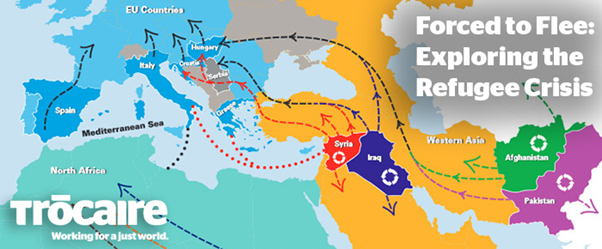|

Over recent weeks, we have all been shocked by the awful images of refugee families and the shocking scenes of bodies washing up on beaches as desperate people try to make their way to Europe.
While this crisis has rightfully grabbed the world's attention recently, it is not a new crisis. Trócaire, Ireland's overseas development agency,
has been working with refugees in a variety of countries and situations for many years. For example, for almost five years now, Syrians have taken shelter
in Lebanon, Turkey and Jordan to escape civil war. Over 250,000 people have died, 12 million are homeless and more than 4 million of them are refugees.
Ancient communities of Christians and Yazidis have been destroyed.
As a result of the current conflicts, a river of distressed humanity flows into the heart of Europe.
While the overwhelming European response is to welcome these people, there is also a realisation that something important and irreversible is
taking place before our eyes. People want to help, but they also need information in order to understand the causes and effects of these conflicts
if they are to be able to make informed decisions about how best to respond.
Trócaire's two-page, full colour resource, "Forced to Flee: Exploring the Refugee Crisis", is both timely and informative.
It will help the classroom teacher to examine the Refugee crisis in both a factual and practical way. Page one begins by giving clear and concise
definitions of the terms "refugee" and "migrant" and the difference between them. It then goes on to explain terms such as 'asylum seeker'
and 'Internally Displaced Person' or IDP. It includes a map showing Europe, Africa and Western Asia, highlighting the main conflict zones in
Afghanistan, Pakistan, Iraq, Syria, Somalia, Eritrea and South Sudan. Arrows show the routes that the refugees have taken over land and where
they have crossed by sea. Colourful graphs show the percentages of refugees and asylum seekers in each country. The Schengen Agreement, which
permits people to travel freely throughout twenty-six European countries, is also explained.
Page two of the resource begins by suggesting tips for helping to create a welcoming and safe place in your school or classroom for all
children regardless of their nationalities, languages and cultural or religious backgrounds. The remainder of the resource outlines suggestions for
four different lessons spanning both the primary and post-primary curricula in both Southern Ireland and Northern Ireland.
The first lesson has suggestions for exploring the map and helping pupils to familiarise themselves with each country. The second lesson
explores the main religions of each country and looks at religious intolerance as a factor in some of the conflicts. It also features Catholic
Social Teaching as the catalyst for inspiring us to act to help our brothers and sisters in their time of need. The third lesson invites the pupils to
imagine a new world. Inspired by the Universal Declaration of Human Rights, it asks them to create a charter for living together in this new world.
The fourth lesson invites the pupils to use their newly acquired knowledge and understanding to inhabit the persona of a particular character and
engage in a talk-show debate on the Refugee Crisis.
Trócaire's resource is fully downloadable and free of charge from their website or by clicking the link below.
http://www.trocaire.org/sites/trocaire/files/resources/edu/resource_refugee_crisis.pdf
|



